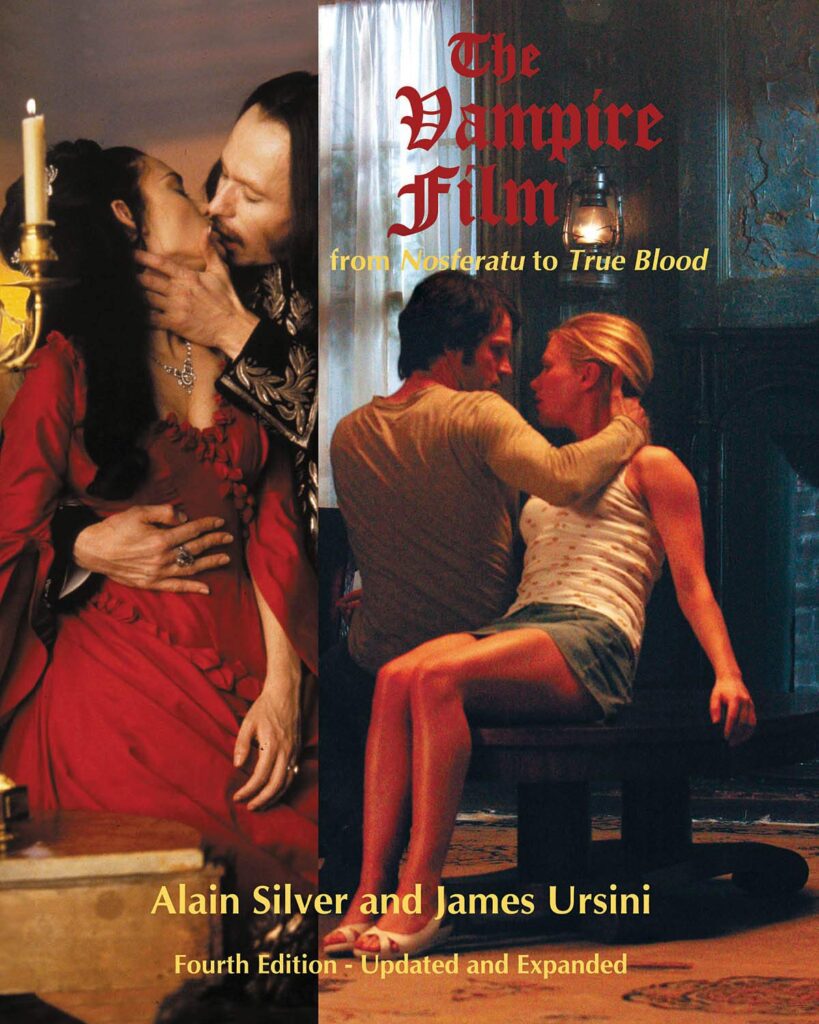
Recently in the history of our humble little planet, we’ve witnessed a ruthless dictator’s toppling demise, the occupation of Wall Street by protestors, the threat of a complete shut-down of the government, and two — two — incredibly bizarre (not to mention highly inaccurate) promises of the end of the world by the same Christian nutjob (which many people actually fell for the first time ’round). It’s madness, to say the very least. And yet, despite all the daily dangers to economies and budgets around the world, there’s something comforting and buoyant over reference books about vampires in the motion picture industry still being published — especially ones that have been printed several times before!
The Fourth Edition of The Vampire Film boasts the updated subtitle From Nosferatu to True Blood, which is more appealing to the average set of eyes (where applicable) when you compare it to a previous heading that read From Nosferatu to Twilight. Indeed, that god-awful, teeny-bopper fad of a franchise may be thoroughly unpleasant to anyone that grew up with the likes of Bela Lugosi, Christopher Lee, Frank Langella, or even Gary Oldman as the reigning Dracula, but no one can safely say that it hasn’t caused the public’s fascination with bloodsuckers from beyond the grave to wane in any way.
And so, authors Alain Silver and James Ursini have gone back to their already wonderful reference book and expanded it to include several more recent entries of vampire lore. Anyone who’s on the hunt for some information regarding the more classic movies in this particular horror movie subgenre — from decidedly accurate adaptations of Bram Stoker’s original undying novel like the episode Great Performances from 1977 with Louis Jourdan, to unabashed bastardized rip-offs like the bizarro Filipino shitfest Batman Fights Dracula, or the unforgettable William Beaudine/John Carradine collaboration, Billy the Kid Versus Dracula.
Now, being that one guy who grew up seeking out the strangest and most unimaginably horrendous movies ever produced, I had a great time just flipping through The Vampire Film: From Nosferatu to True Blood’s filmography alone. Crazy Mexi-horrors, European cult classics, even the strange Japanese offerings to the field: they’re all there, beginning with the “Sources of Vampire Lore in Film” — in which we explore the earliest myths of the fabled nocturnal creatures, before moving onto chapters devoted to the classic cinematic incarnations (“The Male Vampire” and “The Female Vampire”) and the more modern filmic contributions (“Dracula, A.D., 1992” and “Countess Dracula, A.D. 1992” — the latter of which has a subsection on those lesbian vampire films some of us grew up admiring).
When is a vampire movie not really a vampire movie? A chapter entitled “Stylistic Variations” travels through those various lands and worlds of those strange-but-nevertheless-notable titles wherein American distributors picked up the rights to some foreign horrors, but changed their English-language titles to deliberately mention those timeless variety of ghouls in question (which were very big in box offices at the time) — despite the fact that said films did not feature any bloodsuckers. For example, the oddly-named Planet of the Vampires, known in its native Italy as Terrore Nello Spazio (Terror In Space) is actually an epic science fiction opus from Mario Bava — with a planetful of parasitic fiends besieging a group of stranded astronauts.
The Vampire Film: From Nosferatu to True Blood wraps up its Updated and Expanded Fourth Edition with a look at “The Vampire at the Millennium” (one of the really great things about the book is that it keeps its opinions relatively unbiased: it may mention the outline of Twilight, but won’t insult those who are pro or anti by reviewing it per se) and “Vampiress Rising” (which spotlights the rising amount of feminism in the genre).
And the whole book is loaded with stills and rare poster artwork to boot, too, so that’s a plus.
Highly recommended — even for those of you who don’t cater much to the subject.